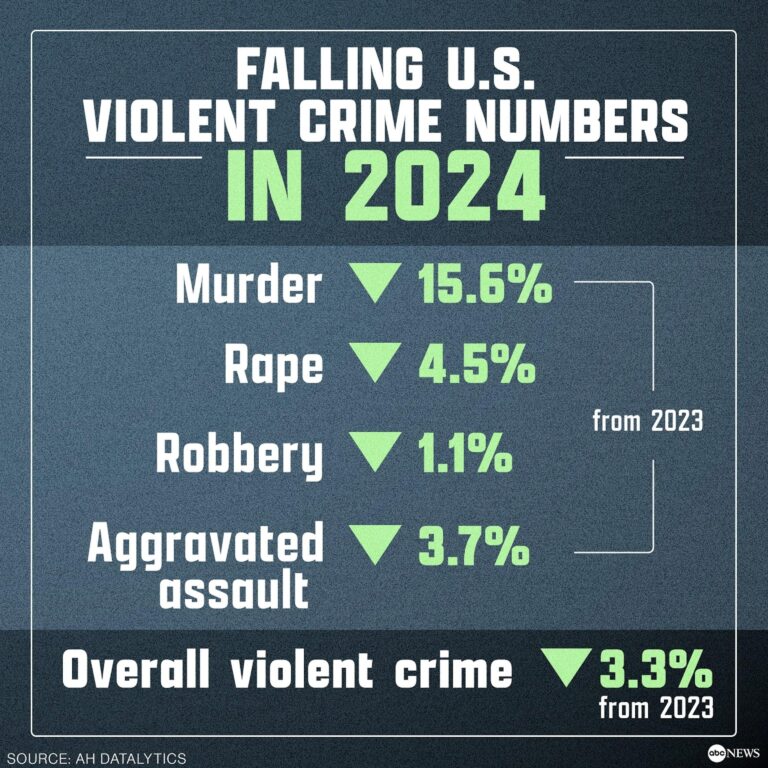Understanding the Contradiction Between Falling Homicide Rates and Rising Public Fear
Although homicide rates across the United States have steadily decreased this year, public anxiety about crime remains disproportionately high. According to the latest FBI reports, major metropolitan areas have seen a consistent drop in murder incidents, a testament to improved policing methods and community partnerships. Yet, surveys indicate that many individuals still feel threatened by violent crime, revealing a puzzling divergence between actual crime data and public sentiment.
- Media Sensationalism: News outlets often highlight rare but dramatic violent episodes, distorting the overall crime picture.
- Social Media Virality: Crime-related videos and posts spread rapidly, intensifying fears despite their infrequency.
- Historical Trauma: Past surges in violence continue to influence how communities perceive safety today.
| Year | Homicide Rate (per 100,000) | Percentage Reporting Fear (%) |
|---|---|---|
| 2021 | 6.5 | 72 |
| 2022 | 5.9 | 68 |
| 2023 | 5.3 | 70 |
Experts emphasize that neglecting the public’s fear can erode trust between communities and law enforcement agencies. To effectively address this gap, authorities must combine transparent crime reporting with educational outreach that empowers residents. Bridging the divide between perception and reality is essential for cultivating neighborhoods where people feel both safe and well-informed.
Exploring the Disparity Between Crime Data and Public Perception
Despite measurable improvements in homicide statistics over the past year, community confidence in safety has not seen a corresponding rise. This phenomenon highlights a broader challenge: statistical progress does not automatically translate into a sense of security. Several factors contribute to this persistent unease, including the amplification of crime stories by media, entrenched neighborhood reputations, and personal encounters with less severe criminal acts.
Key influences shaping public perception include:
- Media Narratives: Headlines often spotlight violent crimes, overshadowing positive trends.
- Social Sharing: Personal accounts and rumors circulate quickly, sometimes exaggerating the threat.
- Uneven Crime Reduction: Not all neighborhoods experience the same level of improvement, leaving some areas feeling vulnerable.
| Factor | Effect on Public Perception | Actual Crime Trend |
|---|---|---|
| Media Coverage | Heightened visibility of violent incidents | Overall crime down 12% |
| Community Stories | Emotional impact increases fear | Homicides decreased by 8% |
| Neighborhood Disparities | Fear concentrated in specific districts | Multiple areas report fewer incidents |
How Media and Social Narratives Amplify Crime Anxiety
In today’s digital era, the nonstop news cycle and pervasive social media platforms often magnify fears about crime beyond what statistics justify. Sensational headlines and graphic visuals are crafted to capture attention but can distort the public’s understanding of crime trends. Media outlets tend to focus heavily on violent episodes, frequently neglecting the broader context of declining crime rates. This imbalance is intensified by social media algorithms that prioritize engagement, pushing alarming crime stories to vast audiences regardless of their actual relevance or frequency.
Factors fueling heightened fear despite falling homicide numbers include:
- Selective News Reporting: Focus on rare, shocking crimes eclipses coverage of safer trends.
- Social Media Spread: Viral content often circulates faster than accurate information.
- Community Storytelling: Shared personal experiences and rumors deepen insecurity.
| Media Element | Effect on Public Perception |
|---|---|
| Breaking News Alerts | Trigger immediate anxiety and amplify crime fears. |
| True Crime Shows & Podcasts | Shape long-term beliefs about crime prevalence. |
| Local News Coverage | Influences fear levels within specific communities. |
Building Community Trust Through Innovative Safety Initiatives
To close the gap between public perception and actual crime trends, law enforcement agencies are intensifying efforts to increase transparency and community involvement. Programs such as community patrols and public safety forums encourage open dialogue, enabling residents to voice concerns and collaborate on customized crime prevention strategies. These efforts are supported by data-driven policing that targets high-risk areas while maintaining respectful engagement with the broader community.
- Frequent community-led safety education sessions
- Accessible real-time crime tracking applications
- Collaborations with local nonprofits for youth engagement
- Enhanced officer training focused on reducing bias and improving cultural awareness
Technological advancements are also playing a pivotal role. The adoption of predictive analytics and surveillance tools, governed by strict privacy safeguards, aims to prevent crime proactively while respecting civil rights. Below is a summary of recent technology deployments alongside improvements in emergency response and community satisfaction:
| Technology | Implementation Rate | Improvement in Response Time | Community Approval Rating |
|---|---|---|---|
| AI-Enhanced Dispatch Systems | 65% | 15% | 70% |
| Public Safety Mobile Apps | 80% | 10% | 68% |
| Body-Worn Cameras | 90% | 7% | 75% |
| Community Alert Networks | 55% | 12% | 60% |
Conclusion: Addressing the Perception Gap to Strengthen Public Safety
Even as homicide rates continue to decline nationwide, public apprehension about crime remains stubbornly high. This disconnect reveals the intricate relationship between objective crime data and subjective community feelings. To foster trust and improve public confidence, it is crucial for policymakers and law enforcement to communicate transparently and implement strategies that tackle both actual safety and the underlying causes of fear. Moving forward, bridging this divide will be essential for creating safer, more resilient urban environments where residents feel genuinely protected and informed.




